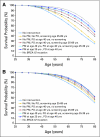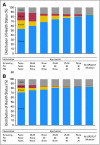Survival analysis of cancer risk reduction strategies for BRCA1/2 mutation carriers
- PMID: 19996031
- PMCID: PMC2815712
- DOI: 10.1200/JCO.2009.22.7991
Survival analysis of cancer risk reduction strategies for BRCA1/2 mutation carriers
Abstract
Purpose: Women with BRCA1/2 mutations inherit high risks of breast and ovarian cancer; options to reduce cancer mortality include prophylactic surgery or breast screening, but their efficacy has never been empirically compared. We used decision analysis to simulate risk-reducing strategies in BRCA1/2 mutation carriers and to compare resulting survival probability and causes of death.
Methods: We developed a Monte Carlo model of breast screening with annual mammography plus magnetic resonance imaging (MRI) from ages 25 to 69 years, prophylactic mastectomy (PM) at various ages, and/or prophylactic oophorectomy (PO) at ages 40 or 50 years in 25-year-old BRCA1/2 mutation carriers.
Results: With no intervention, survival probability by age 70 is 53% for BRCA1 and 71% for BRCA2 mutation carriers. The most effective single intervention for BRCA1 mutation carriers is PO at age 40, yielding a 15% absolute survival gain; for BRCA2 mutation carriers, the most effective single intervention is PM, yielding a 7% survival gain if performed at age 40 years. The combination of PM and PO at age 40 improves survival more than any single intervention, yielding 24% survival gain for BRCA1 and 11% for BRCA2 mutation carriers. PM at age 25 instead of age 40 offers minimal incremental benefit (1% to 2%); substituting screening for PM yields a similarly minimal decrement in survival (2% to 3%).
Conclusion: Although PM at age 25 plus PO at age 40 years maximizes survival probability, substituting mammography plus MRI screening for PM seems to offer comparable survival. These results may guide women with BRCA1/2 mutations in their choices between prophylactic surgery and breast screening.
Conflict of interest statement
Authors' disclosures of potential conflicts of interest and author contributions are found at the end of this article.
Figures


Comment in
-
Weighing options for cancer risk reduction in carriers of BRCA1 and BRCA2 mutations.J Clin Oncol. 2010 Jan 10;28(2):189-91. doi: 10.1200/JCO.2009.25.6875. Epub 2009 Dec 7. J Clin Oncol. 2010. PMID: 19996025 No abstract available.
-
Survival analysis of cancer risk reduction strategies for BRCA1/2 mutation carriers.J Am Coll Surg. 2011 Sep;213(3):447-50. doi: 10.1016/j.jamcollsurg.2011.06.421. J Am Coll Surg. 2011. PMID: 21871383 No abstract available.
References
-
- John EM, Miron A, Gong G, et al. Prevalence of pathogenic BRCA1 mutation carriers in 5 US racial/ethnic groups. JAMA. 2007;298:2869–2876. - PubMed
-
- National Comprehensive Cancer Network. Genetic Familial High-Risk Assessment: Breast and Ovarian. V. 1.2009. http://www.nccn.org/
-
- Saslow D, Boetes C, Burke W, et al. American Cancer Society guidelines for breast screening with MRI as an adjunct to mammography. CA Cancer J Clin. 2007;57:75–89. - PubMed
-
- Domchek SM, Friebel TM, Neuhausen SL, et al. Mortality after bilateral salpingo-oophorectomy in BRCA1 and BRCA2 mutation carriers: A prospective cohort study. Lancet Oncol. 2006;7:223–229. - PubMed
Publication types
MeSH terms
Grants and funding
LinkOut - more resources
Full Text Sources
Other Literature Sources
Medical
Miscellaneous

